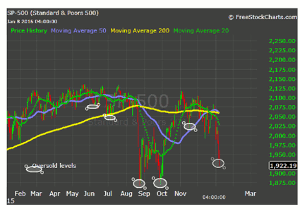In light of the many questions that have been raised due to the slowdown in China, Tom Cleveland, on ForexTraders.com, examines several global currencies and urges traders to remember that whenever chaos returns, the foreign exchange market will be the first to telegraph the volatility.
If last week was any early indication, 2016 will be a bust of a year. According to one analyst, “We’re just 11 days into 2016 and the Dow Jones Industrial Average is already down 6.2% for the year while the Russell 2000 small-cap index, which is on the verge of an outright bear market, is off 7.9% for the year and has lost 19.2% from its high set last summer.” Is there a guilty party for this sudden turmoil? Of course there is and it is none other than China and a raft of questionable data points.
As Chinese officials desperately attempt to right the economic ship of the Middle Kingdom, the feedback loop of financial data from a variety of sectors is delivering a report card with poor marks, to say the least. One of the more troubling pieces of data has been the outflow of investment capital, as investors rush for the exits while the Shanghai Composite continues its freefall to who knows where: “From institutional data, we can observe that capital outflows from China are reaching record highs, with nearly $930 billion pouring out from Q2 2014 to Q3 2015.” Ouch!
For the past month, technical pundits have been circulating their latest favorite chart that shows an eerie correlation between the S&P 500 (SPX) and the Shanghai Composite indices. The only problem with it, which is substantial, is that the perspective shown is deceptive. Scale does mean something. For example, the two indices appear to move in tandem, but over the past six months, the S&P 500 fell only 8%, while the Shanghai exchange was off 24%. Yes, last week was a bad one, but, for the first two days of this week, the S&P has rebounded to the 1938 support level, thus countering an oversold condition:
Why the Noise About China Causing Currency Wars in Asia?
Much has already been written about the disastrous impacts on emerging markets that the slowdown in China has created. As economic activities lessened and infrastructure projects were completed or curtailed, the need to import raw materials, primarily from developing countries that depend on China’s support, waned. The precipitous and immediate drop in demand for the world’s hard and soft commodities from China has also led to a flight of capital from both China and its business partners, weakening national currencies right and left.
Currency depreciation has hit hard in places like Brazil, where a major drop has occurred. Political conditions in Brazil have not helped either, but the harsh pain related to cross-border purchasing power has especially been felt in Asian countries like Korea and Australia. Over the past four trading days of last week, the Korean won fell roughly 3%, while the Aussie collapsed about 5%. The Japanese yen actually strengthened, based on the news from China alone, but the Bank of Japan may have to intervene to keep its weakened posture reasonably intact.
These changes are also not related to the Fed raising interest rates. Even Ben Bernanke, the former Fed chairman, has scoffed on his blog that to accuse the US of orchestrating a currency war lacks sufficient evidence to give the argument any credence. To have a currency war, you must weaken your national currency, and the greenback has been in appreciation mode for some time. To read the entire article and see the charts click here…
By Tom Cleveland, Contributor, ForexTraders.com






















